Topographie

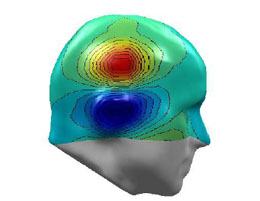
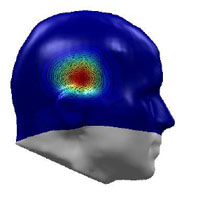
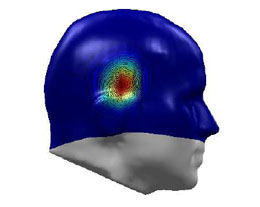
Scalp
topography and magnetic field are oriented perpendicularly:
| EEG |
MEG |
|
| Potential
/ Magnetfeld Topographie |
 |
 |
| L2 –
Minimum Norm |
 |
 |
Radial sources do not generate a
measurable magnetic field:
 |
EEG |
MEG |
| Potential
/ Magnetfeld Topographie |
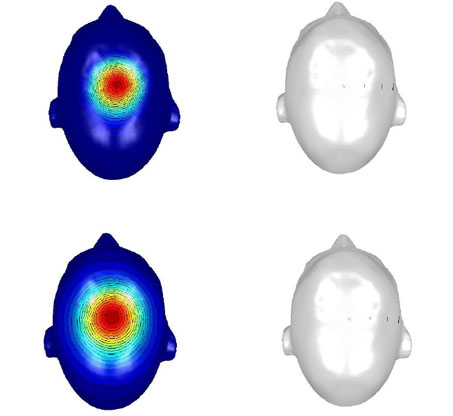 |
|
| L2 – Minimum Norm | ||
The EEG Reference Dependency:
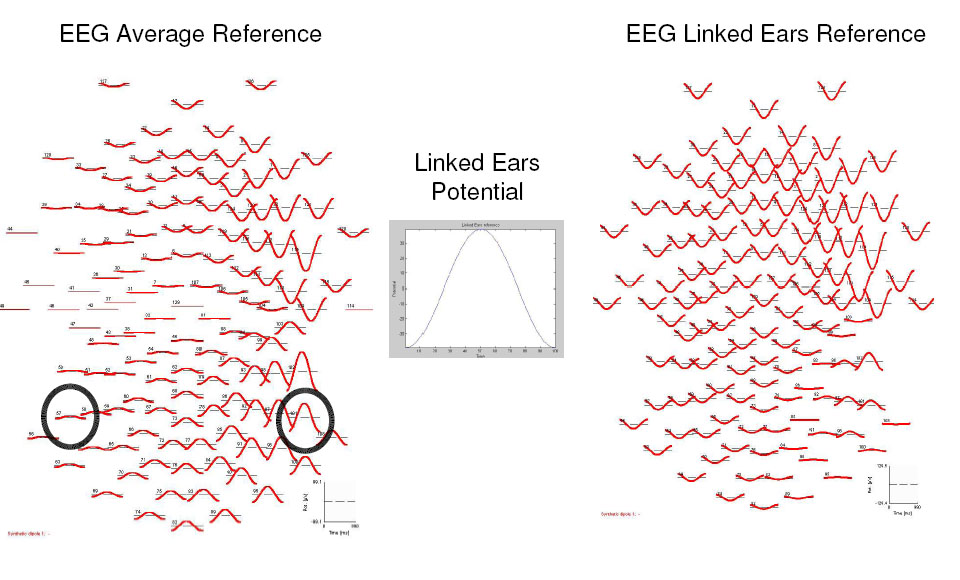
Inverse Methods are reference
independant:
| |
EEG
Average Reference |
EEG
Linked Ears Reference |
| Potential Topographie | 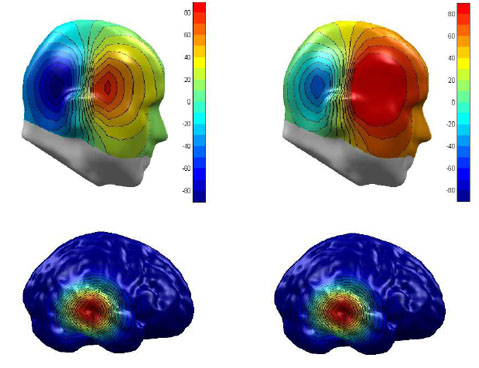 |
|
| L2 – Minimum Norm | ||
| EEG |
MEG |
| Measures
surface potentials of extracellular currents generated by synchronous
excitatory postsynaptic potentials at apical dendrites of several thousands of adjacent and similarly oriented pyramidal cells. |
Measures
external magnetic fields of intracellular currents generated by
synchronous excitatory postsynaptic potentials at apical dendrites of
several thousands of adjacent and similarly oriented pyramidal cells. |
| Measures
radial and tangential sources |
Measures
mainly (90%) tangential sources |
| Is reference
dependent |
Is reference
independent |
| Inverse
solutions, CSD, Average Reference are reference independent (not
uncritical) |
Is reference
independent |
| Scalp
potentials do strongly depend on volume conductor properties. The
inverse solutions do strongly depend on the correct modeling of such
properties. |
External
magnetic fields depend to a smaller degree on volume conductor
properties. The inverse solutions do thus lesser depend on the correct
modeling of such properties. |
| Independent
of sensor orientation |
Dependent on
sensor orientation |
| In first
approximation independent of sensor positioning (standard positions).
For better approximation measurement of head shape and sensor
coordinates necessary. |
Always
dependent on sensor configuration (no standard positions) =>
Measurement of head shape and sensor coordinates always necessary. |
| Group level
statistical analysis possible in sensor domain (in first approximation ) |
Group level
statistical analysis not possible in sensor domain (normalization on
standard sensor system necessary ) |
| Smaller
impact of movements (electrode positions stay identical, noise
increases). |
Strong
influence of movements (correction not yet possible). |
| Strong
superposition of multiple generators even if far away from each other. |
Smaller
superposition of multiple generators. |
| Stronger
impact of ocular artifacts, lesser impact of cardiac artifacts |
Stronger
impact of cardiac artifacts, lesser impact of ocular artifacts |
| Smaller
temporal stability due to changing impedancies |
High
temporal stability |
| Smaller
impact of environmental noise (shielding chamber beneficial but not
necessary) |
Strong
impact of environmental noise (shielding chamber necessary) |
| Small
attenuation of deep sources |
Stronger
attenuation of deep sources, especially in gradiometer systems with
small baseline |
| High
dimensionality of the source space (radial & tangential,
superficial & deep sources) => High ambiguity of the inverse
solution |
Smaller
dimensionality of the source space (no radial, no deep sources) =>
Smaller ambiguity of the inverse solution |
| Smaller
localization accuracy on single subject level due to volume conductor
dependencies. |
Higher
localization accuracy on single subject level. On group level
advantageous if based on big N. (structural and functional intersubject
variance asks for smoothing). |
| Small head
size dependency |
Stronger
head size dependency. Smaller heads show worse S/N. |
| up to 256
sensors |
up to 275
sensors |
| Medium
investment and medium operating costs |
High
investment and high operating costs |